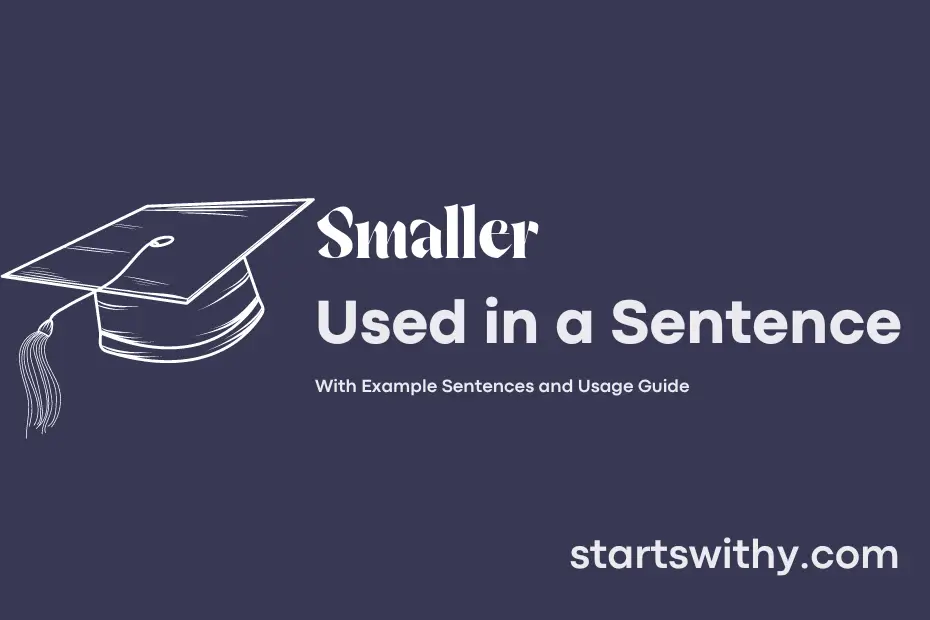Do you struggle with knowing when to use “smaller” in a sentence? The word “smaller” is a comparative adjective that is used to describe the size of something in relation to another thing. It is often used when comparing two items, indicating that one is less large or more compact than the other.
Understanding how to properly use “smaller” can enhance the clarity and precision of your language. By mastering the use of this comparative adjective, you can effectively communicate the differences in size between objects and convey your thoughts with greater accuracy.
7 Examples Of Smaller Used In a Sentence For Kids
- I have a smaller teddy bear than my friend.
- The puppy is smaller than the big dog.
- My sister has a smaller pencil case than me.
- The red ball is smaller than the blue ball.
- I like the smaller cupcake because it is cute.
- The yellow flower is smaller than the pink flower.
- The car is smaller than the truck.
14 Sentences with Smaller Examples
- The smaller dorm room may have limited space, but it’s cozier and easier to manage.
- Opting for a smaller portion at the canteen can help save money and prevent food wastage.
- Using a smaller font size can help fit more content on a single page for assignments.
- Consider downsizing your wardrobe to a smaller selection of versatile clothing items.
- When conducting group discussions, it’s crucial to give a voice to the smaller minority of opinions.
- A smaller study group may offer a more focused environment for collaborative learning.
- Choose a smaller backpack to avoid straining your shoulders during long days on campus.
- Adjusting your study schedule to focus on smaller segments of time can improve concentration.
- Investing in a smaller laptop can provide similar benefits with added portability for students on the go.
- Opt for a smaller study desk to save space in your room while maintaining a conducive study environment.
- Splitting larger tasks into smaller manageable chunks can ease the pressure and enhance productivity.
- Sustainable living practices like using smaller reusable water bottles can reduce plastic waste on campus.
- Joining smaller clubs or societies can offer more intimate networking opportunities for students.
- Setting aside a smaller budget for leisure activities can help students maintain financial balance.
How To Use Smaller in Sentences?
To use the word Smaller in a sentence, simply follow these steps:
-
Identify the Context: Before using the word Smaller, make sure you understand the context in which you want to use it. Smaller is often used to compare the size or quantity of two or more things.
-
Choose Comparison: Decide what two or more things you want to compare in terms of size or quantity. For example, you might want to compare two fruits, two animals, two countries, etc.
-
Construct the Sentence: Once you have identified the context and the comparison you want to make, construct a sentence that clearly illustrates the difference in size or quantity using the word Smaller. For example, “The apple is smaller than the watermelon.”
-
Check Grammar: Make sure the sentence is grammatically correct. Ensure that the subject and verb agree, and that the sentence is clear and concise.
-
Practice: To become more comfortable using the word Smaller in sentences, practice constructing different examples in various contexts. This will help you become more adept at incorporating the word into your writing or conversation.
By following these steps, you can effectively use the word Smaller in a sentence to compare the size or quantity of two or more things. With practice, you will become more proficient at using this word naturally in your everyday communication.
Conclusion
In conclusion, sentences with smaller word counts are often easier to comprehend and more efficient in conveying information. By using concise language, writers can enhance the clarity of their message and maintain the reader’s attention. The simplicity of sentences with fewer words allows for a more direct and effective communication, making the text accessible to a wider range of audiences.
Additionally, sentences with smaller word counts can improve the overall readability and impact of a piece of writing. This approach promotes brevity and precision, eliminating unnecessary details and ensuring a more focused delivery of the main ideas. Therefore, incorporating sentences with smaller word counts can greatly benefit the clarity and effectiveness of written communication.



